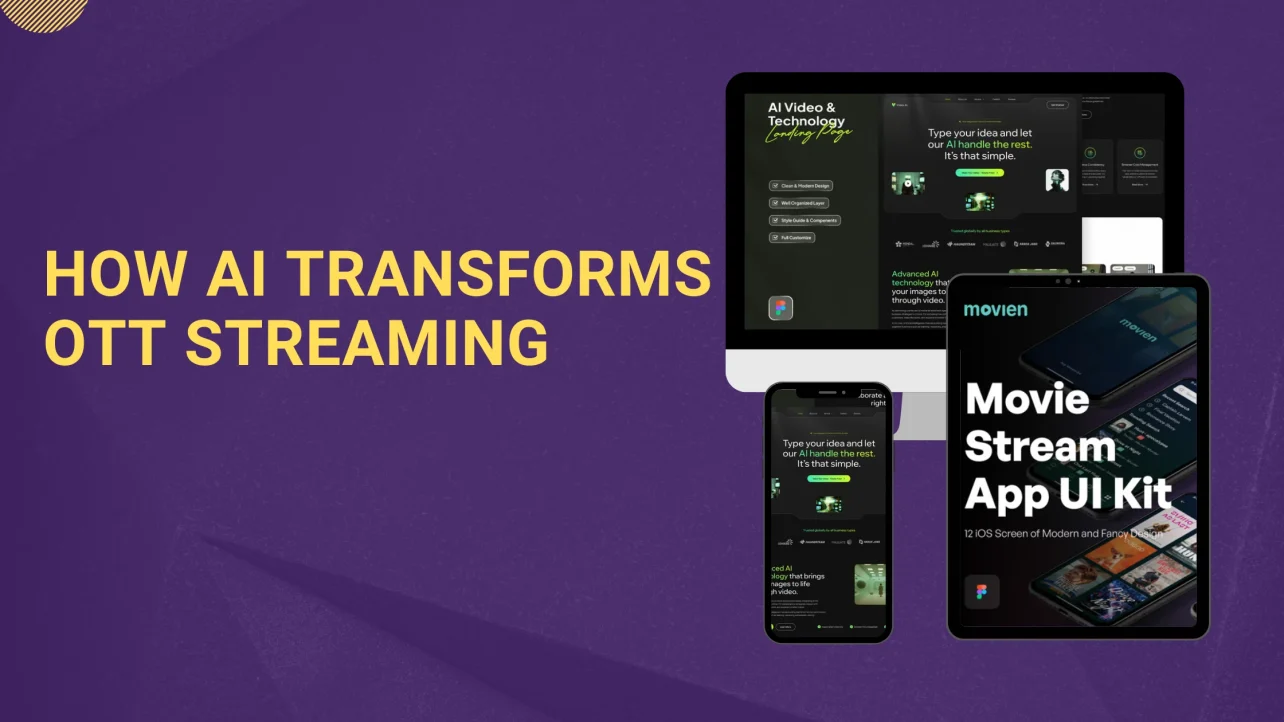Introduction: The Role of AI in Modern OTT Platforms
Over-the-top (OTT) platforms have become the backbone of modern entertainment, offering on-demand access to movies, TV shows, live sports, and exclusive content across multiple devices. As global viewership continues to rise, competition among streaming services is fiercer than ever. Audiences expect not only high-quality streaming but also personalized, seamless, and engaging experiences.
This is where Artificial Intelligence (AI) is revolutionizing the landscape. From content discovery and recommendation engines to real-time analytics and targeted advertising, AI is transforming OTT platforms into intelligent ecosystems that adapt to user behavior. According to PwC, global OTT revenue is projected to reach $275 billion by 2027, and AI-driven personalization is expected to play a central role in sustaining this growth.
In this blog, we’ll explore how AI is reshaping OTT platforms, the opportunities it creates, the challenges of implementation, and the future of smarter streaming solutions.
What Is AI in OTT Streaming?
Artificial Intelligence in OTT refers to the integration of machine learning (ML), natural language processing (NLP), computer vision, and predictive analytics into streaming platforms. Unlike traditional systems, which rely on fixed rules, AI algorithms continuously learn from user behavior, adapting in real time to deliver better experiences.
Key applications include:
- Content personalization – recommending shows and movies tailored to individual tastes.
- Video optimization – improving playback quality through AI-powered compression and adaptive streaming.
- Monetization – enabling smarter, non-intrusive ad placements.
- Content protection – using AI to detect piracy and moderate user-generated videos.
AI ensures OTT platforms are not just delivering content, but also creating customized entertainment journeys for each viewer.
AI-Powered Content Recommendations for Better Engagement
Recommendation engines are the most visible impact of AI on OTT platforms. Netflix reports that over 80% of watched content comes from AI-driven recommendations, proving their importance in engagement and retention.
How it works:
- Behavioral analysis: Tracks viewing history, ratings, and even pauses.
- Collaborative filtering: Suggests shows watched by people with similar interests.
- Contextual data: Uses device type, time of day, and demographics to refine results.
Impact on OTT:
- Boosts watch time by surfacing relevant titles quickly.
- Reduces churn as subscribers find value in staying.
- Increases loyalty by creating a “personalized feed” unique to each user.
For example, if a user often watches action movies on weekends, the platform may push trailers for upcoming blockbusters every Friday, keeping engagement high.
Enhancing User Experience with Personalized Streaming
AI doesn’t just decide what content viewers should watch; it personalizes how they watch it.
Examples include:
- Dynamic thumbnails: AI tests multiple poster images and displays the one most likely to attract a click.
- Language preferences: Platforms like Disney+ Hotstar auto-select subtitles or dubbing based on prior choices.
- Smart notifications: Personalized alerts remind users of live events, new releases, or similar shows.
Personalization turns an OTT app into a unique environment for each subscriber, making them feel valued and understood.
AI in Video Compression and Adaptive Bitrate Streaming
Streaming high-resolution video to millions of viewers is bandwidth-intensive. AI-driven video compression and adaptive bitrate streaming (ABR) solve this challenge.
- AI compression: Reduces file sizes without noticeable quality loss by predicting patterns in frames.
- Adaptive Bitrate (ABR): Dynamically adjusts video quality based on internet speed and device performance.
According to Akamai, ABR reduces buffering by up to 40%, ensuring smooth playback even on low networks. For live sports or breaking news, this can mean the difference between a satisfied viewer and a frustrated one.
Benefits:
- Lower bandwidth costs for providers.
- Smooth, buffer-free experiences for viewers.
- Wider reach in markets with weaker internet infrastructure.
Smarter Content Discovery and Search with AI
With libraries holding thousands of titles, content discovery is a major challenge. AI improves search through:
- Natural Language Processing (NLP): Users can type or speak queries like “feel-good comedies under 2 hours.”
- Voice search integration: Smart assistants enhance accessibility.
- Mood-based discovery: Suggests playlists based on sentiment or genre preferences.
By reducing “choice overload,” AI ensures users find relevant content faster, which increases session time and satisfaction.
AI for Targeted Advertising and Monetization in OTT
Ad-supported video-on-demand (AVOD) is growing rapidly, with eMarketer predicting it will account for $70 billion in ad spend by 2027. AI enables platforms to deliver ads that feel relevant rather than intrusive.
AI’s role in advertising:
- Audience segmentation: Groups viewers based on age, interests, and purchase history.
- Dynamic Ad Insertion (DAI): Places personalized ads into live and on-demand streams in real time.
- Contextual targeting: Aligns ads with relevant genres (sportswear ads during football matches).
Benefits:
- Higher ROI for advertisers.
- More revenue for platforms.
- Less irritation for users, as ads align with interests.
This creates a win-win ecosystem, where monetization doesn’t come at the cost of user experience.
Improving Video Analytics with AI Insights
AI-driven analytics empower OTT providers to go beyond surface-level data.
Examples:
- Heatmaps: Identify where viewers skip or drop off.
- Churn prediction models: Forecast which users are at risk of unsubscribing.
- Content performance: AI helps decide which originals to renew or cancel.
According to Deloitte, data-driven content decisions reduce production risks by 30%, making AI essential in managing billion-dollar content libraries.

AI in Content Moderation and Copyright Protection
Piracy and inappropriate content are major threats to OTT platforms. AI tools mitigate these risks through:
- Automated moderation: Identifying nudity, violence, or hate speech in user-generated content.
- Content fingerprinting: Detecting unauthorized distribution of copyrighted shows or movies.
- Ad safety: Ensuring ads don’t appear beside harmful content.
By protecting both viewers and creators, AI helps OTT providers maintain credibility and trust.
Enhancing Live Streaming with Real-Time AI Applications
Live streaming is booming, from sports to concerts and webinars. AI improves both production and user experience:
- Automated highlights: Creates instant replays and social snippets.
- AI-powered captions: Generates real-time subtitles for accessibility.
- Smart cameras: Auto-adjust framing and angles without manual intervention.
Case in point: During the Tokyo Olympics, AI-powered systems handled real-time translations across multiple languages, making the event globally accessible.
Challenges of Implementing AI in OTT Platforms
Despite its advantages, integrating AI is not without hurdles.
- Data Privacy Concerns – AI relies heavily on personal data. Regulations like GDPR and India’s DPDP Act demand strict compliance. A breach can result in fines and loss of trust.
- High Implementation Costs – Developing AI infrastructure and hiring data scientists require major investment. Smaller OTT services may struggle to keep up with giants like Netflix.
- Algorithmic Bias – If AI is trained on biased datasets, recommendations may exclude diverse content, reducing fairness and inclusivity.
- Scalability Challenges – AI models must process data from millions of concurrent users, which requires robust cloud infrastructure.
- Transparency Issues – Users often don’t understand why certain recommendations are shown, leading to concerns about manipulation.
Future of AI-Driven OTT Streaming Solutions
The future promises even deeper integration of AI into OTT ecosystems.
- Hyper-Personalization: Beyond recommending content, AI will predict the right time and right device for watching, shaping viewing habits.
- Generative AI in Content Creation: Studios may use AI to generate trailers, summaries, or even scripts, reducing costs and speeding up production cycles.
- Immersive Experiences with AR/VR: AI will merge with augmented and virtual reality, enabling interactive streaming like “choose-your-own-adventure” shows.
- AI-Enhanced Sports Streaming: Real-time analytics, virtual commentators, and predictive highlights will redefine how fans engage with live sports.
- Smarter Ad Ecosystems: Programmatic advertising will evolve with AI-driven bidding, delivering highly relevant ads in milliseconds.
- Sustainability with AI Optimization: AI will help reduce data center energy usage by optimizing streaming efficiency, supporting greener entertainment.
Conclusion
Artificial Intelligence is no longer just an enhancement for OTT—it is the driving force behind smarter, more engaging streaming experiences. From recommendation systems and adaptive streaming to targeted advertising, content protection, and live event optimization, AI is redefining digital entertainment.
Yes, challenges exist—privacy, scalability, and costs—but the future clearly points toward AI-powered OTT ecosystems that deliver hyper-personalized, efficient, and innovative experiences to global audiences.
For viewers, this means content that feels tailor-made. For providers, it means higher engagement, reduced churn, and sustainable monetization. As AI continues to evolve, OTT platforms will not just distribute content; they will curate personalized worlds of entertainment for every user.
The era of AI-driven OTT streaming has arrived—and it’s only just beginning.


No comments yet